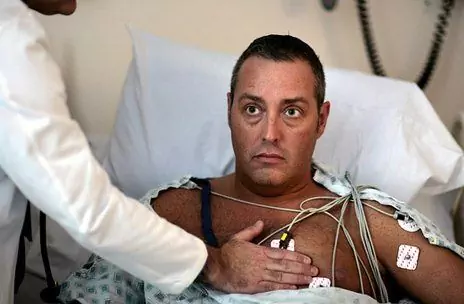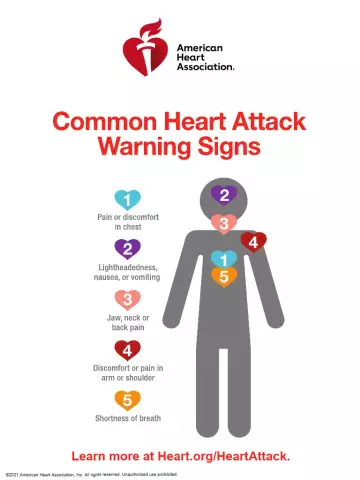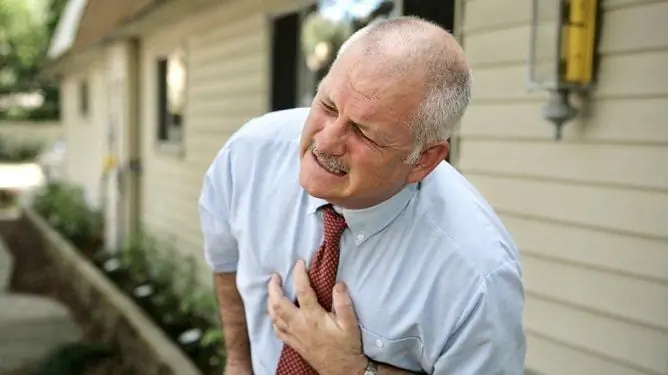- Author Rachel Wainwright [email protected].
- Public 2023-12-15 07:39.
- Last modified 2025-11-02 20:14.
Heart arythmy
Brief description of the disease

Cardiac arrhythmia is understood as a set of cardiac arrhythmias. These disorders have a different cause, mechanisms of development, clinical manifestations and prognosis. Therefore, when diagnosed with cardiac arrhythmia, treatment is prescribed only after a comprehensive examination of the patient, determining the nature of the disease and the clinical picture of its development.
As a rule, cardiac arrhythmia is detected after organic damage to the organ (defects, pathologies, myocardial infarction), but there are often cases when the disease occurs due to dysfunctions of the nervous system, intoxication or changes in the water-salt balance in the body. Note also that cardiac arrhythmias can also appear in completely healthy people under the influence of colds, physical fatigue, or, say, alcoholic beverages.
Another important point: many rhythm disturbances (atrial premature beats) may not be felt by a person at all and do not lead to any serious consequences. In this case, doctors talk about non-cardiac pathology and take measures to find the underlying disease. On the other hand, cardiac arrhythmias, the causes of which are caused, for example, by ventricular tachycardia, are far from so harmless, because they are the cause of sudden cardiac arrest in 83% of reported cases. No less dangerous for the patient are AV blockade and bradycardia (we will talk about them a little below), often leading to loss of consciousness and death.
Heart arrhythmia - causes of the disease
Heart rhythm disturbances appear due to:
- endocrine disorders, including a drop in blood sugar or an increase in the amount of thyroid hormones;
- violations of water-salt or acid-base balance;
- intoxication;
- atherosclerosis;
- congenital malformations of the cardiovascular system.
Once again, we note that when a heart arrhythmia is diagnosed, the symptoms depend not only on the cause that caused the adverse changes, but also on the nature of the disease itself. For this reason, both in our country and abroad, situations often arise when the elimination of the cause of the disease does not lead to the restoration of a normal heart rhythm. Only accurate data on various types of cardiac arrhythmias and the laws of their development will help to cope with this misfortune.
Types of cardiac arrhythmias
In general, cardiac arrhythmias, the symptoms of which depend on many factors, are accompanied by a decrease in heart rate (less than 60 beats per minute), its increase (more than 100 beats per minute), or irregular heartbeats. Within the framework of this classification, scientists distinguish dozens of types of cardiac arrhythmias, but we will only talk about the most common of them - bradycardia (cardiac arrhythmia with a rare rhythm) and tachycardia (disorders accompanied by an increased heart rate).
The main types of bradycardia are mild sinus arrhythmia of the heart (sick sinus syndrome) and atrioventricular block (more commonly referred to as AV block). The types of tachycardia are much more diverse, but the main ones are atrial fibrillation (atrial fibrillation), supraventricular tachycardia, and ventricular tachycardia. All these types are subdivided into paroxysmal and permanent. The former are characterized by a sudden increase in rhythm, which can last as long as a few seconds, or several hours or even days. If a person develops a paroxysmal arrhythmia of the heart, the consequences are usually not so serious, since the disturbance in the rhythm goes away by itself without outside intervention or after taking widespread heart drugs. Persistent tachycardias are much more dangeroussince they are resistant to drug therapy and cause constant stress on the heart, which, of course, significantly reduces the life of a person.
With regard to bradycardia. The most famous of them is sick sinus syndrome, caused by impaired passage of the impulse when the sinus node and atrial tissues come into contact. Sinus arrhythmia of the heart can also be observed in completely healthy people who regularly play sports, but much more often it is a consequence of pathological conditions. In particular, it is caused by: high blood pressure, hypothyroidism, some infectious diseases.
Arrhythmia of the heart - symptoms and clinical picture of the disease
The manifestations of bradycardia and tachycardia are different, so we will consider them in isolation from each other.
A rare heart rhythm (bradycardia) is accompanied by the following symptoms:
- general weakness;
- dyspnea;
- dizziness;
- fast fatiguability;
- frequent cases of darkening in the eyes;
- states close to loss of consciousness, when a person, only at the cost of great efforts, manages to maintain balance and perform habitual actions.
Bradycardia is characterized by short-term loss of consciousness. Without feelings, a person lies only for a few seconds, less often for minutes. Atrial fibrillation and other types of tachycardia cannot boast of such humanity, since for a long time they deprive the patient of the ability to perceive the surrounding reality and often require immediate resuscitation to save human life. In all other respects, the symptoms of tachycardia are similar to the manifestations of bradycardia.
Note that in some cases, cardiac arrhythmia may be accompanied by signs of acute or chronic heart failure (respiratory failure, pulmonary edema, a sharp drop in blood pressure), and in others - instant loss of consciousness and clinical death. As you can see, this disease manifests itself in radically opposite signs, and, perhaps, this is precisely its main danger.
Arrhythmia of the heart - treatment with traditional methods
The only effective way to get rid of most types of bradycardia is to implant a permanent pacemaker. Its installation is justified in cases where a person exhibits symptoms of atrioventricular block or sinus arrhythmia of the heart, accompanied by a decrease in the rhythm to 40 or less beats per minute. If bradycardias do not have pronounced clinical manifestations, doctors limit themselves to general therapy and do not see the need for urgent surgical intervention.
Since atrial fibrillation (atrial fibrillation) can be either paroxysmal or permanent, treatment depends on the nature of the rhythm disturbances. Infrequent attacks stop, and permanent ones require regular medication and prevention of strokes. To stop the development of an attack, novocainamide and quinidine are used. In recent years, new drugs have been increasingly used, for example, cordarone or propanorm. If the patient has no contraindications to general anesthesia, atrial fibrillation can be controlled by electrical cardioversion. In this case, all the necessary measures must be carried out within 48 hours, otherwise the risk of blood clots and the appearance of other complications increases significantly.
Ventricular tachycardia is also life-threatening. It requires urgent medical attention, since it quickly develops to a state of clinical death, in which only resuscitation measures can help. In this case, the patient must be correctly laid down on a hard surface (by throwing his head back as much as possible or turning it on its side in case of vomiting), check the independence of breathing and, in the absence of it, give artificial respiration and indirect heart massage.
Arrhythmia of the heart - treatment with folk remedies

Immediately, we note that when a heart arrhythmia is diagnosed, folk remedies should be used only as an addition to traditional medicines, but in no case should they replace them. In fact, herbs only speed up the healing process, but are not able to cure a person completely. It is from this that one should proceed when choosing the recipes you like.
- mix one bottle of valerian, hawthorn and motherwort alcohol tincture. Shake the mixture well and refrigerate for 1-2 days. The medicine is taken 30 minutes before meals, 1 teaspoon;
- pour 30 hawthorn berries with a glass of boiling water and put the mixture on low heat for 10-15 minutes. The broth is used fresh in equal portions throughout the day;
- chop 0.5 kg of lemons and cover them with fresh honey, adding 20 kernels taken from apricot pits to the mixture. Mix the composition thoroughly and take 1 tablespoon in the morning and in the evening;
- boil a glass of water in an enamel saucepan, and then add 4 grams of adonis herb to it. Simmer the mixture for 4-5 minutes over low heat, then cool it and place the pan in a warm, dry place for 20-30 minutes. The strained broth is stored in the refrigerator, taken 1 tablespoon 3 times a day.
YouTube video related to the article:
The information is generalized and provided for informational purposes only. At the first sign of illness, see your doctor. Self-medication is hazardous to health!






